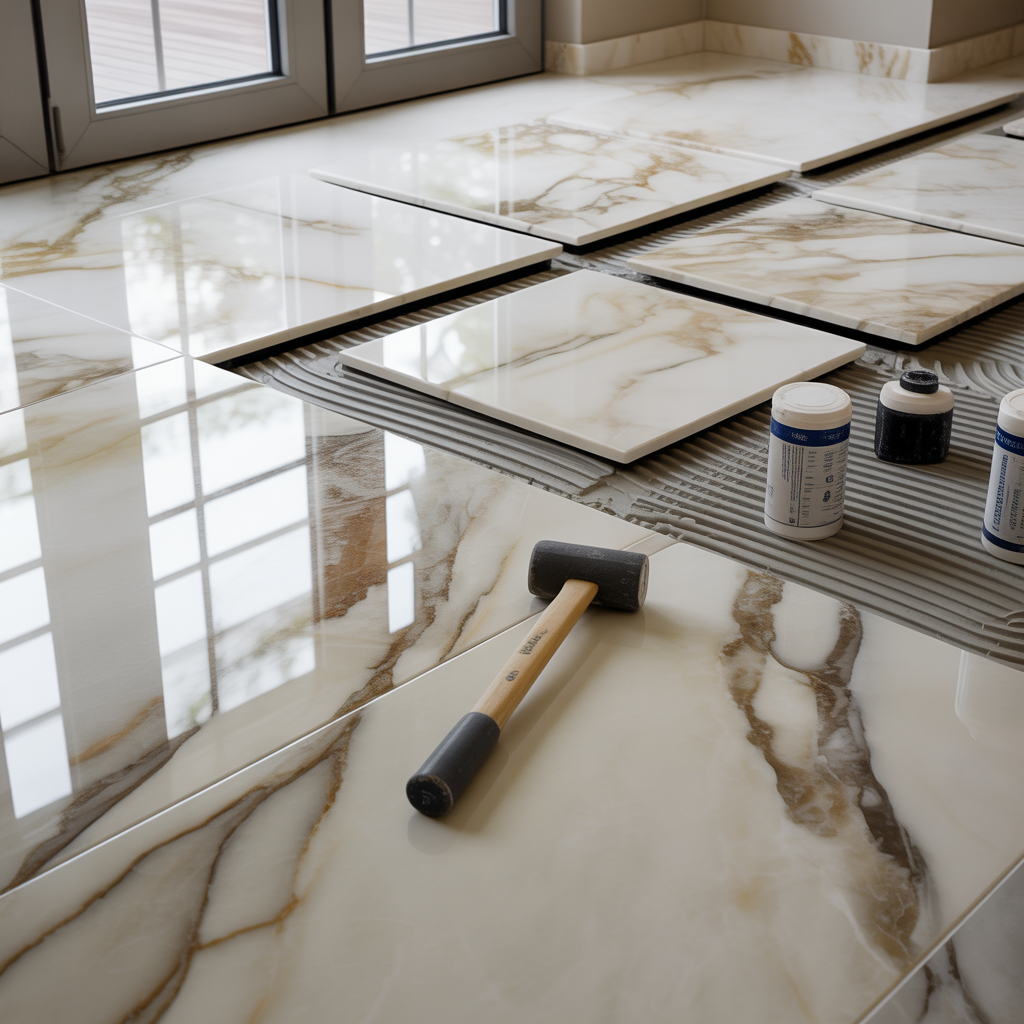Tiling with Natural Stone: A Complete Guide to Choosing, Installing, and Maintaining Your Stone Tiles
Tiling with natural stone is a rewarding choice that brings luxury, durability, and a unique aesthetic to your space. In this article, you will find detailed guidance on selecting the right stone, preparing for installation, executing the tiling process, avoiding common mistakes, and caring for your finished surface to ensure it lasts for years.
What Is Natural Stone Tile?
Natural stone tiles are quarried, cut, and finished from stone materials such as marble, granite, limestone, travertine, slate, and sandstone used for floors, walls, countertops, and other surfaces. Unlike man-made materials like porcelain or ceramic, natural stone has unique variations in colour, veining, and texture because it comes from the earth.
Because of these inherent materials and characteristics, tiling with natural stone requires special considerations, from structural support to sealing and maintenance.
Types of Natural Stone and Their Uses
When you are tiling with natural stone, it is crucial to know which type suits your particular area, traffic level, moisture exposure, and design intent.
Here are some common stone types and their typical applications:
- Marble: This stone is prized for its distinctive veining and elegance. It works beautifully in bathrooms, feature walls, and lighter-traffic areas. However, it is softer and more prone to scratching and etching by acidic substances.
- Granite: Highly durable and less porous than many other stones, granite is an excellent choice for kitchens, hallways, countertops, and other busy spaces.
- Limestone: Offers a softer, more rustic look. It is porous and may require more maintenance, so best suited for moderate-traffic areas or outdoor covered spaces.
- Travertine: Recognisable by its natural voids and pitting, travertine gives a warm, textured look. It must often be filled and carefully sealed.
- Slate: Dense and often more moisture-resistant, slate is suitable for indoor and outdoor use, including patios, but the surface can be uneven and may need more preparation.
- Sandstone/Quartzite: These are often used outdoors or in areas where rugged performance is needed. They typically require a strong substrate and good sealing.
When tiling with natural stone, you should evaluate the stone’s hardness, porosity, thickness, finish, and expected variation from tile to tile. These factors will influence installation ease, maintenance demands, and long-term performance.
How to Choose the Right Stone for Your Space
Selecting the right material is half the battle when tiling with natural stone. Consider the following criteria:
1. Location and traffic
Ask yourself: Is this a floor, wall, countertop or outdoor patio? High-traffic areas such as hallways or commercial zones benefit from tougher stones like granite or slate. Softer stones may work better in bathrooms or feature walls.
2. Moisture exposure and environment
Moisture and temperature fluctuations affect natural stone differently than ceramic. In wet zones or outdoors, you want a stone with low absorption and you must ensure good substrate and waterproofing.
3. Finish and aesthetic
Polished, honed or tumbled finishes each have distinct appearances and maintenance demands. Polished stone shows scratches and water spots more easily. Honed and tumbled finishes can be more forgiving.
4. Variation and batch consistency
Because stone is a natural product, you will see variation in thickness, colour and pattern. Always order extra material (typically 10–15% more) to allow for cuts, waste, and variation.
5. Budget and lifecycle
Natural stone often costs more upfront compared with ceramic or porcelain, but with proper installation and care, it can last for decades.
6. Substrate and support
Stone tiles are heavier and less tolerant of flexible substrates. Ensure the floor or wall structure is adequately strong and stable.
By matching your stone type to the specific demands of your space and usage, you set the stage for a successful tile project.
Planning and Preparation Before Installation
Before the first tile is laid, thorough planning and preparation will make all the difference when tiling with natural stone. Some of the key steps include:
Substrate assessment and preparation
- Check that floors or walls are level, stable, and correctly cured if new (e.g., new concrete or screed).
- Replace unsuitable backer systems (e.g., plasterboard for stone), especially when wall-tiling.
- For floors: ensure dead load and structural stiffness are adequate. Stone tiles often require more support than ceramic tiles.
Layout and tile selection
- Randomly mix tiles from several crates to distribute variation evenly.
- Arrange the layout for visual balance, considering edges, cuts, focal points, and grout lines.
- Buy extra tile to account for cuts and future repairs.
Choosing adhesives, mortars, and grouts
- Use adhesives rated for natural stone—often white cement-based (for light stones) and specially formulated to reduce pigmentation or staining.
- Avoid “dot and dab” methods. A full bed of adhesive behind the tile is crucial to avoid voids, cracking, or unevenness.
- Select grout compatible with natural stone: colour matched, stain-resistant, with correct joint width allowances for variation.
Allowance for movement and thermal expansion
- Movement joints must be incorporated at edges, changes in substrate, or where heating is present.
Sealing and protecting
- Many natural stone types must be sealed prior to grouting to prevent “picture framin,g” where grout darkens the edges of a tile.
- Ensure tile backs are clean, dry, and free from dust or contaminants prior to fixing.
Proper planning this way increases the chances that your project yields a smooth, long-lasting surface.
Step-by-Step Installation for Natural Stone
Here is an enhanced installation guide for tiling with natural stone, reflecting the specialised processes required.
- Prepare the substrate: Confirm the surface is clean, dry, flat, appropriate for stone, and has the correct substrate or underlayment.
- Dry-lay tiles for mock-up: Without adhesive, place a portion of tiles to check variation, placement, pattern, and edge alignment before committing to glue.
- Apply adhesive: Use the correct adhesive for stone. Spread a full bed with a notched trowel, then “back-butter” the tile (apply a thin coat to the back as well) to ensure full contact and no voids.
- Set tiles: Press each tile firmly, check the level frequently, and keep grout joints even. Work out from a fixed datum and maintain consistent spacers.
- Cut and fit tiles: Use a wet saw with a diamond blade to cut stone to size. In DIY or professional settings, the use of proper equipment reduces wastage and damage.
- Allow adhesive to cure: Respect the manufacturer’s recommendations before walking on or grouting the surface.
- Clean the surface and seal if required: Remove any latent mortar or debris. Apply an impregnator or sealer before grouting if the stone is porous.
- Grout: Choose grout that complements the stone. Test a small area first to check for staining or unwanted effects.
- Final seal and cleanup: After the grout cures, apply a final coat of sealer if needed, and clean the surface with a neutral pH cleaner.
- Protect corners and edges: Use profiles or suitable finishes on edges and transitions to avoid damage or chipping over time.
By following these steps carefully, you can achieve a professional finish and long-term performance from your natural stone tiling project.
Things to Consider: Advantages & Disadvantages
Advantages
- Natural stones bring timeless beauty, unique variation, and added value to your home.
- When installed and maintained properly, they can last decades or even a lifetime.
- Many types are excellent for allergy-sufferers since they do not trap dust or off-gas like some materials.
Disadvantages
- Natural stone tends to be heavier and more expensive to install than ceramic or porcelain.
- It may require more maintenance: sealing, careful cleaning, and attention to moisture and stains.
- Some stones can become slippery when wet, fragile under impact, or prone to etching from acidic substances.
- Greater variation in colour and thickness can complicate the installation.
Understanding both sides of the equation helps you decide if tiling with natural stone is the right solution for your project.
Common Mistakes and How to Avoid Them
When tiling with natural stone, avoiding certain mistakes makes the difference between a successful project and one you regret. Here are frequent missteps and how to sidestep them:
- Using the wrong adhesive or insufficient adhesive coverage – Some installers try to use ordinary adhesives or spot-fix tiles. This leads to voids, cracking, or shadows.
- Ignoring substrate strength or flexibility – Stone needs a stiff, stable substrate; tilting onto weak or flexible surfaces leads to failures.
- Not accounting for variation in stone thickness, size, or colour – Choosing tiles from one box only or failing to mix boxes leads to an uneven look.
- Failing to seal or using the wrong cleaning products – Porous stones must be sealed; using acidic or abrasive cleaners can damage them.
- Not incorporating movement joints – Without them, natural expansion or substrate movement can cause cracking or edge damage.
By staying mindful of these mistakes from the start, you increase your chance of a durable and visually pleasing installation.
Maintenance and Care After Installation
Your job is not done once the last tile is fixed. Proper maintenance is key when tiling with natural stone to preserve its appearance and performance.
Daily and Routine Cleaning
- Use a damp soft cloth or mop with pH-neutral stone cleaner. Avoid harsh or acidic cleaners (such as vinegar), which can etch or dull the surface.
- Use mats or rugs in high-traffic areas to reduce wear, grip, and damage.
- Wipe up spills promptly to prevent staining, especially on porous stones like limestone or travertine.
Sealing and re-sealing
- Many natural stones require periodic resealing to maintain protection. The timing depends on the stone, finish, and usage, often every 1–3 years.
- Before sealing, ensure the surface is clean, dry, and free from residues.
Special care for specific stones
- Marble: Avoid acidic substances; use only neutral cleaners.
- Travertine: Fill voids if needed and seal regularly.
- Slate: Inspect for flaking or uneven surfaces and reseal as necessary.
- Granite: Though robust, periodic sealing will help preserve its polished look.
Long-term preservation
- In very busy or heavy-use zones, consider protective measures such as area rugs, furniture pads, and restricting shoes at entrances.
- Periodically check grout and edges for signs of wear or damage and repair proactively.
- When in doubt, consult a stone-care specialist for deep cleaning or restoration.
Consistent upkeep ensures the investment you made in tiling with natural stone continues to pay off for many years.
Conclusion
Tiling with natural stone brings timeless elegance, authenticity, and long-lasting value to your home. To achieve the best results, every step, from selecting the right stone to proper installation and maintenance, must be done with care and precision. When handled correctly, your natural stone surface will stay beautiful and durable for many years.
At SF Marble & Granite, we specialize in services of marble floor installation, granite installation, and countertop installation. Whether you’re enhancing your kitchen, upgrading your bathroom, or giving your floors a stunning new look, our expert team ensures your natural stone tiling is crafted and installed to the highest standards.
FAQs
Is natural stone better than ceramic or porcelain for tiling?
Natural stone offers unique beauty and durability, but it often requires more maintenance than ceramic or porcelain options.
How much extra tile should I buy when using natural stone?
It is typically recommended to purchase an extra 10-15% of tile to allow for cuts, waste, and matching variation.
Can I install natural stone tiles myself, or should I hire a professional?
Because of the additional demands on substrate, adhesive, and handling, hiring a skilled installer is often advisable.
How often do natural stone tiles need to be resealed?
Depending on the stone, finish, and usage, resealing might be required every 1–3 years to maintain protection.
What cleaning products should I avoid on natural stone?
Avoid acidic, abrasive, or ammonia-based cleaners; instead, use a pH-neutral stone cleaner recommended for your particular stone type.

